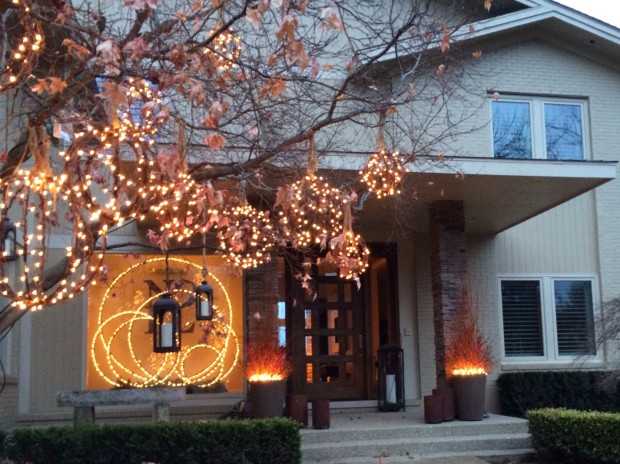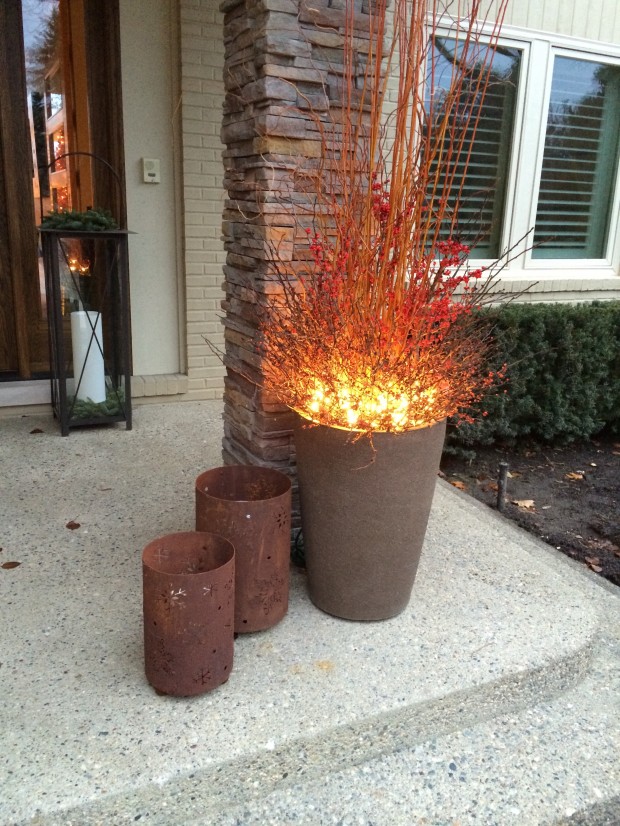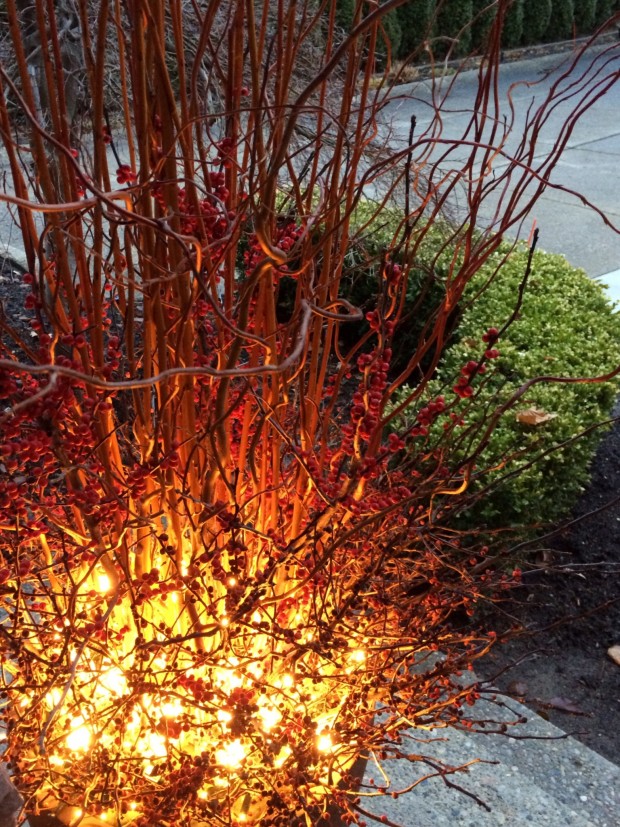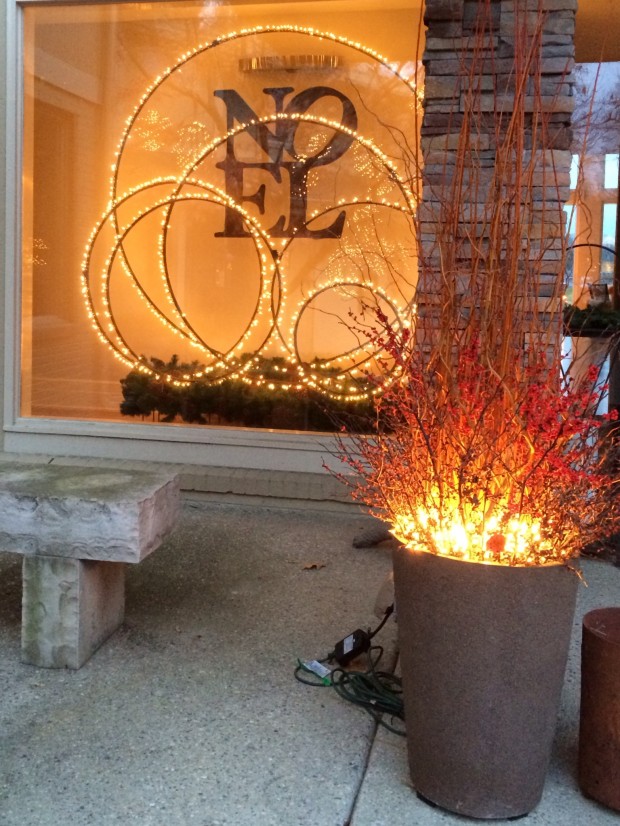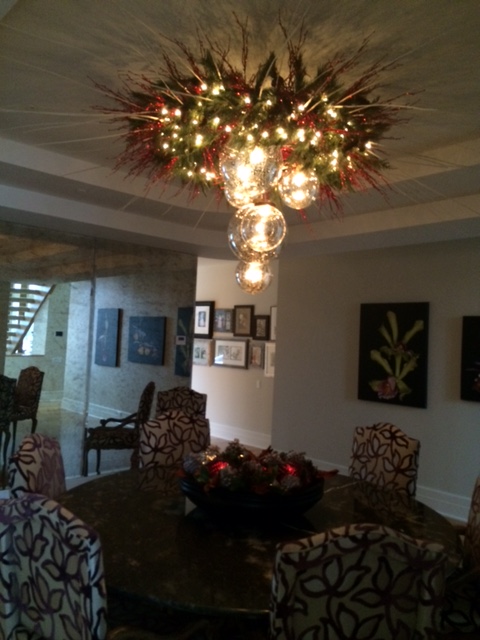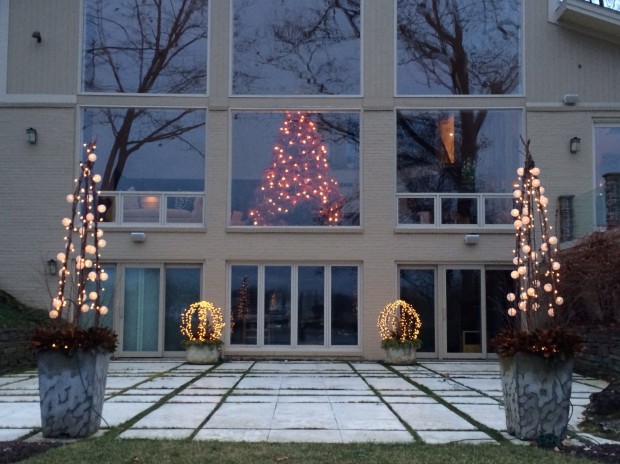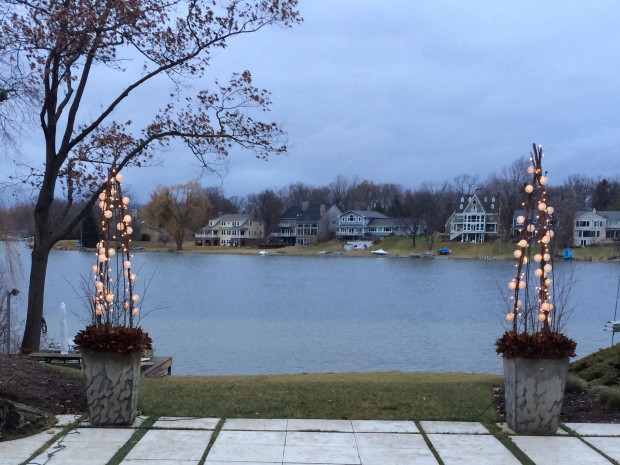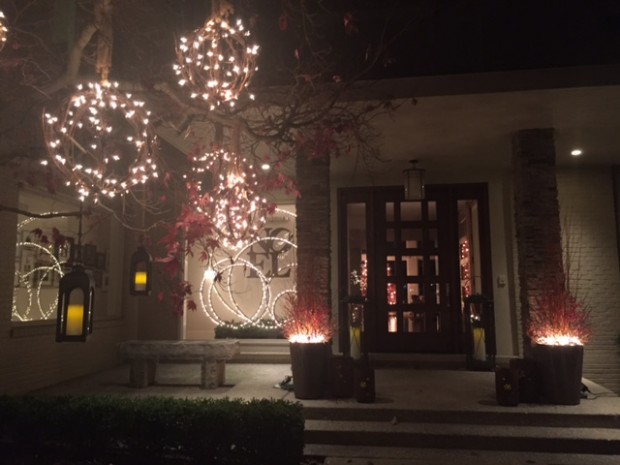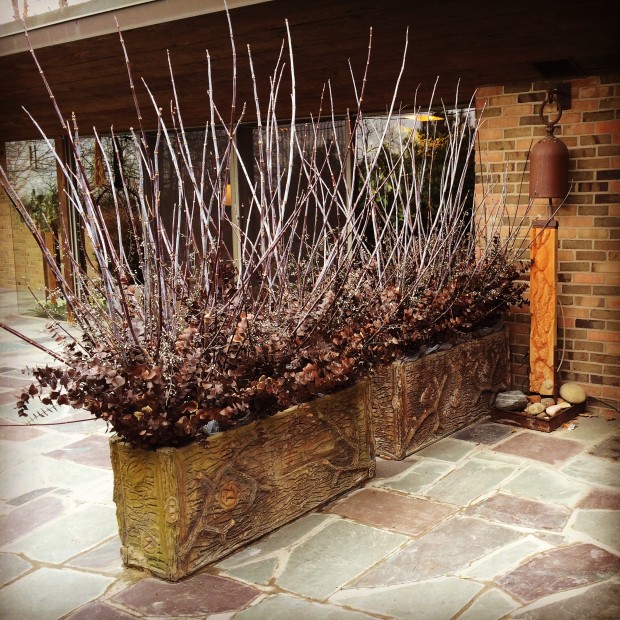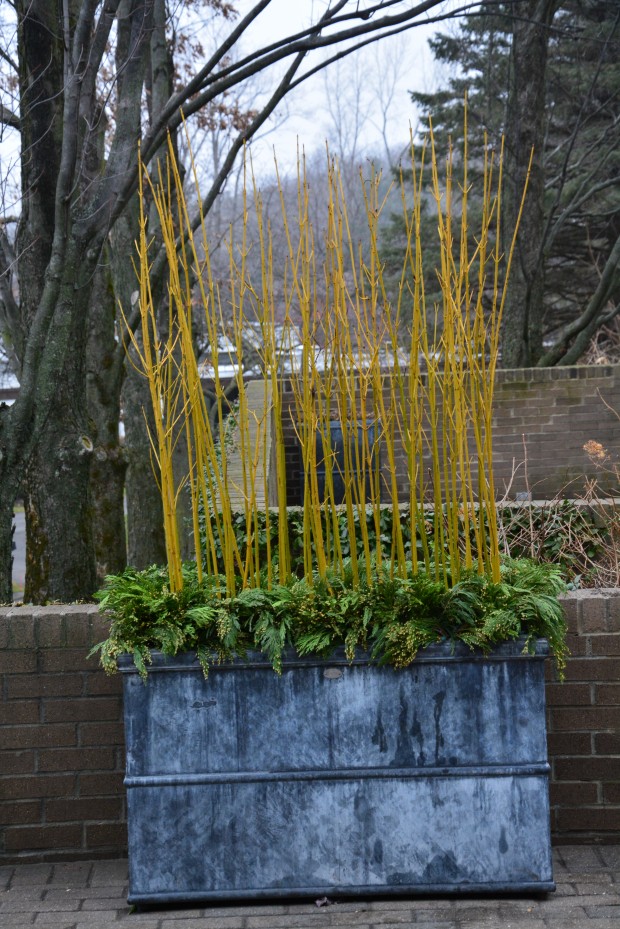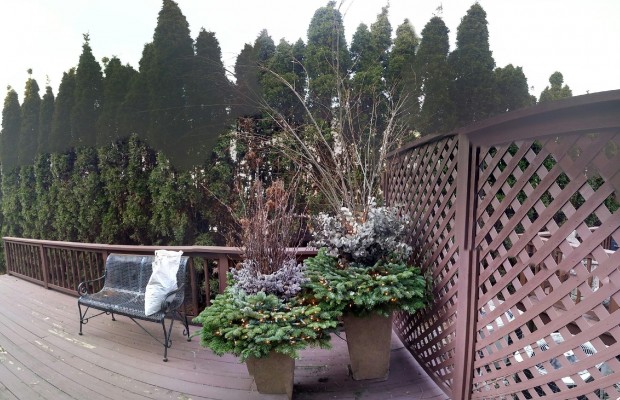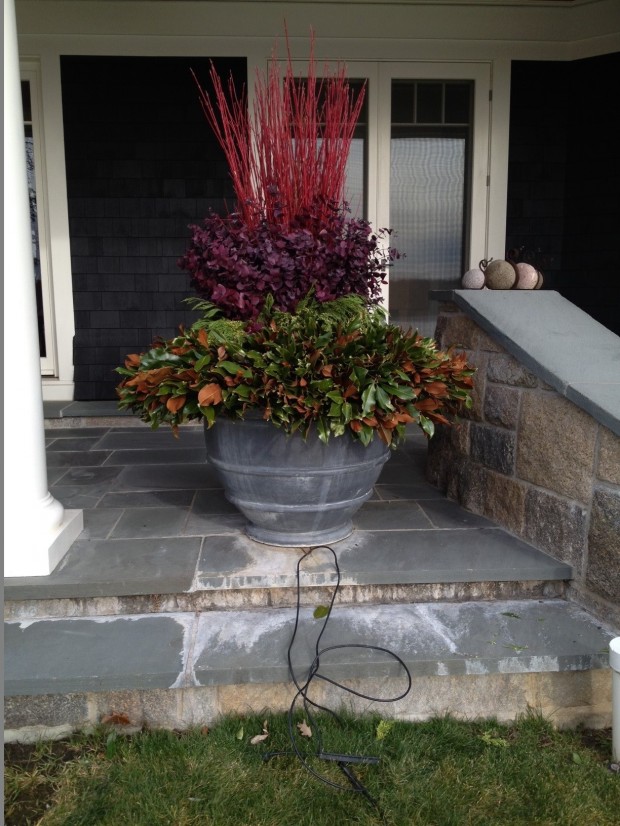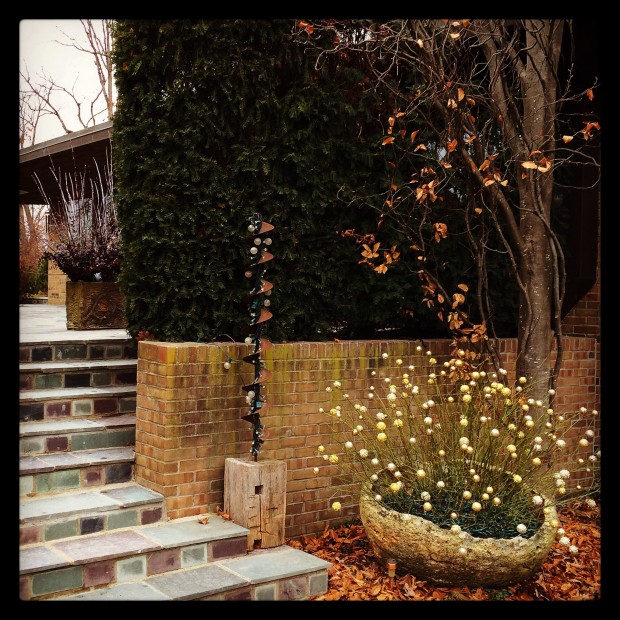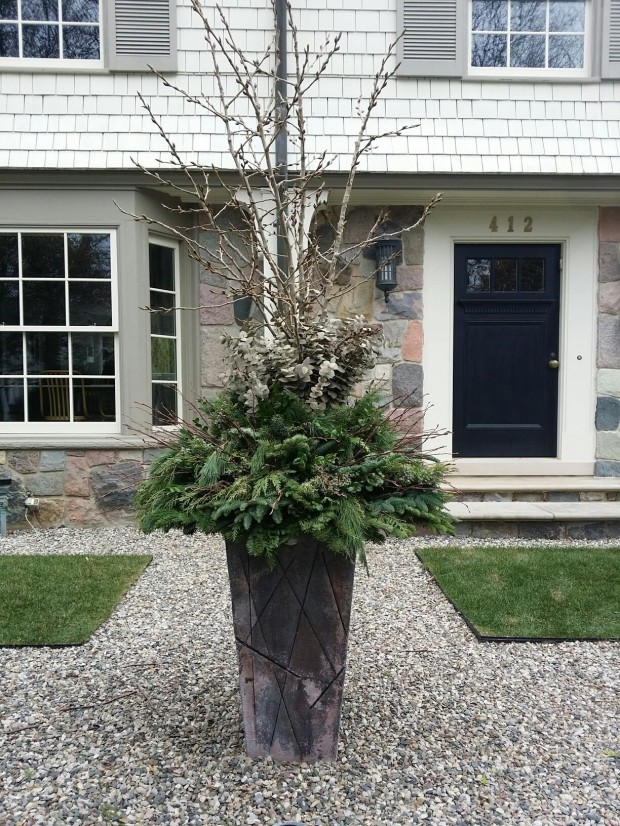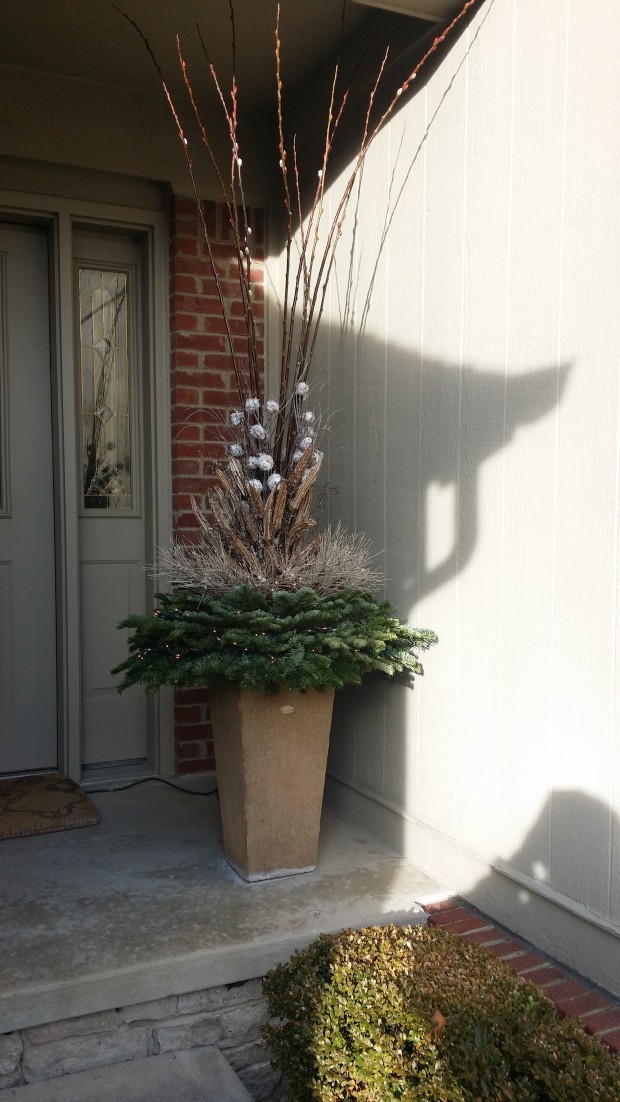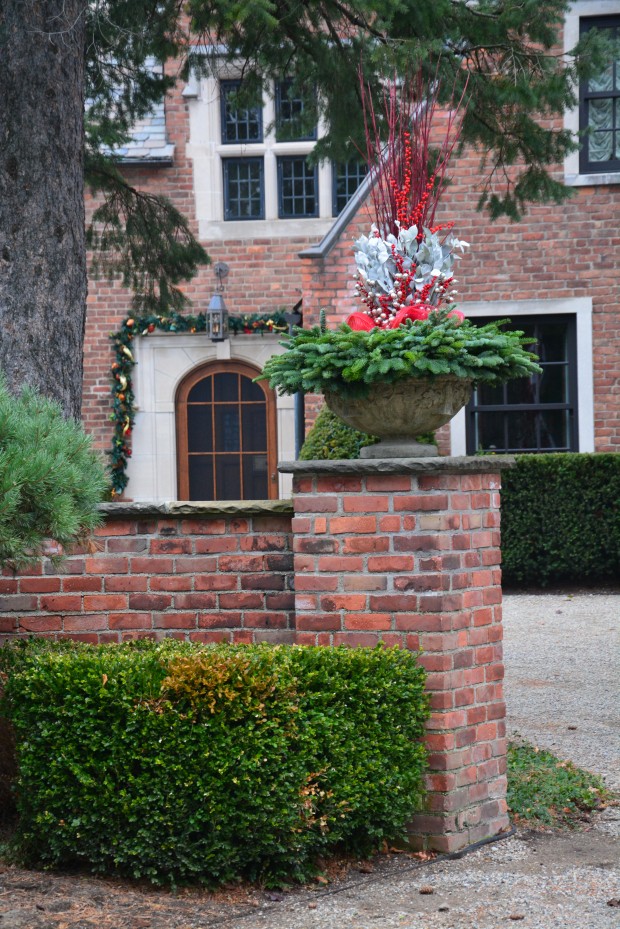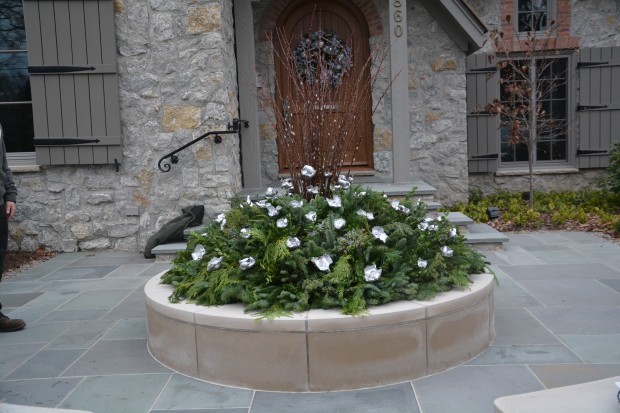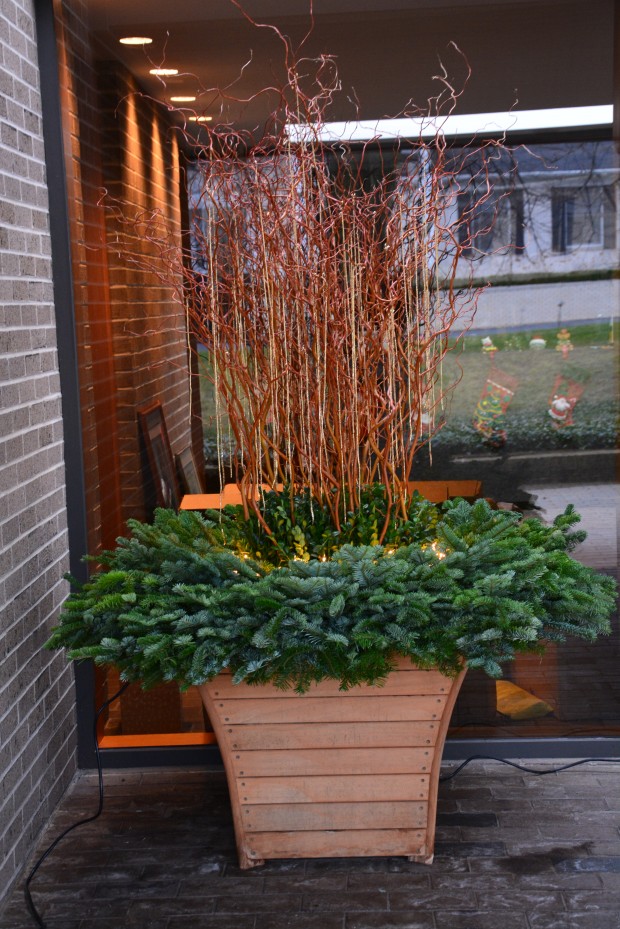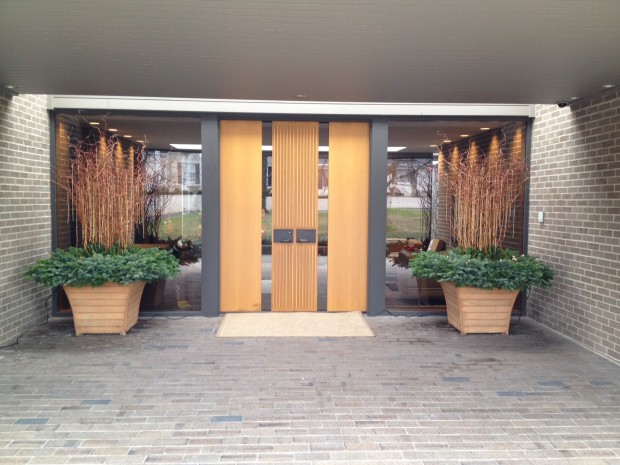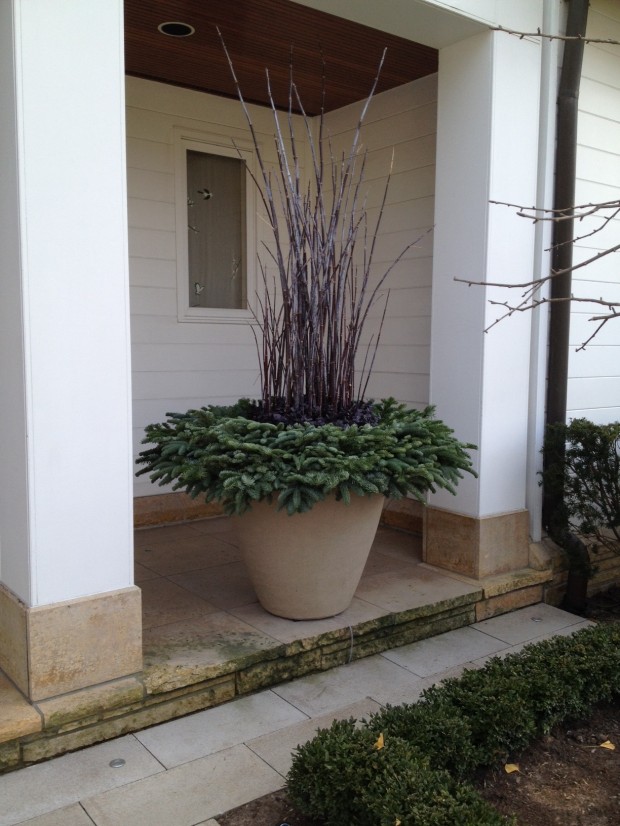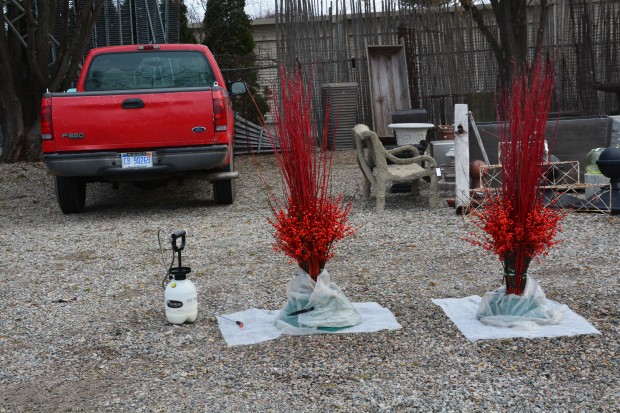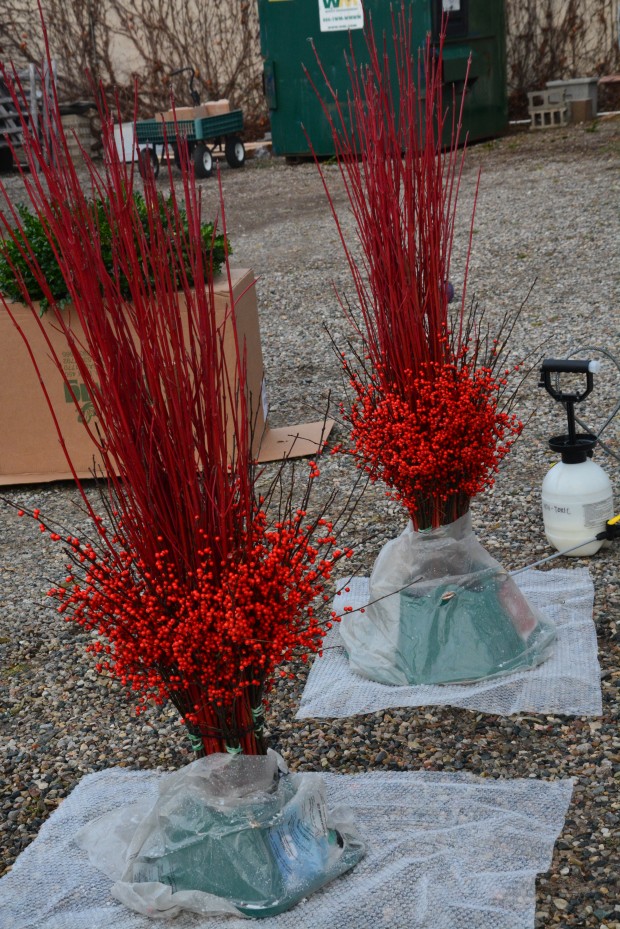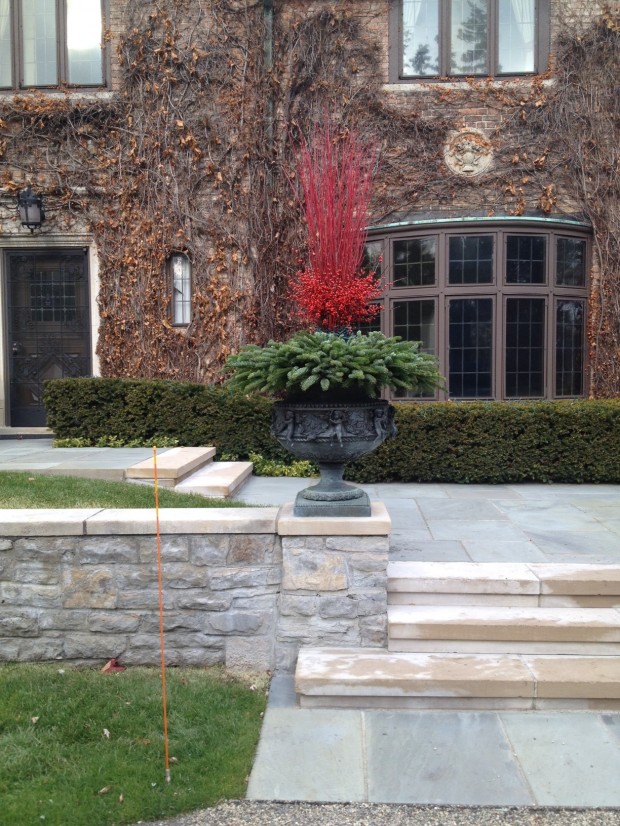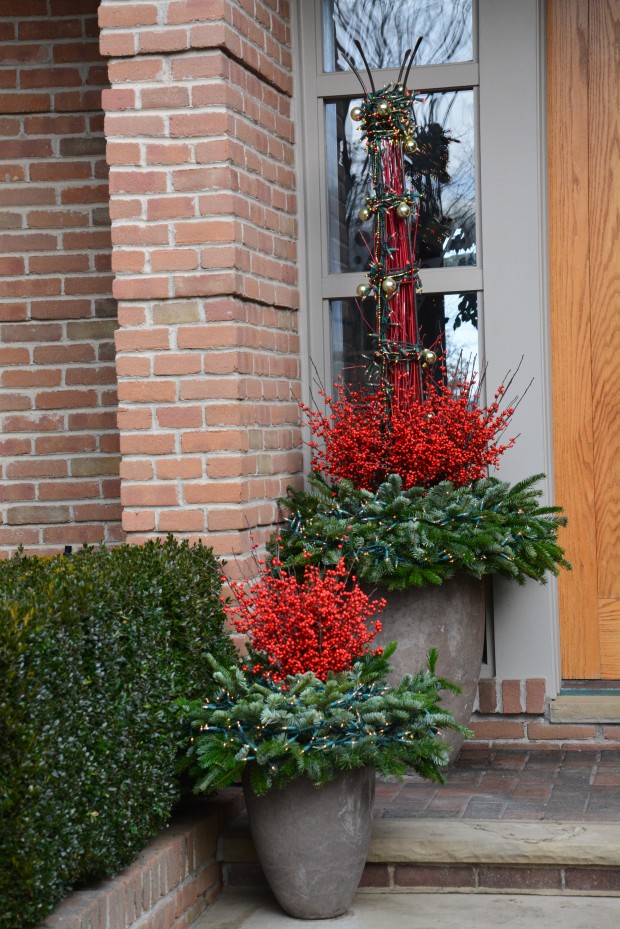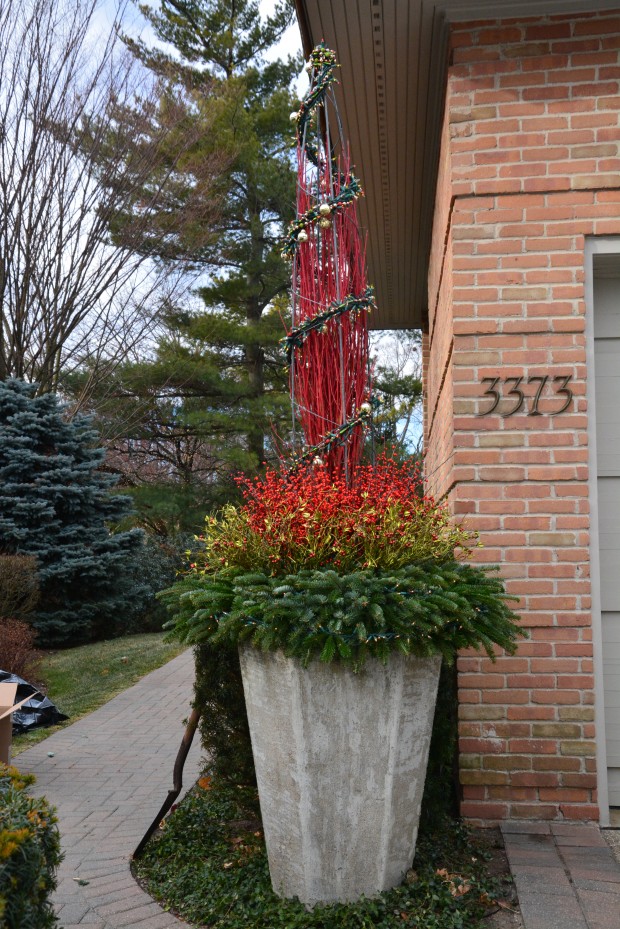 The day we finally get to doing the roof and window boxes at the shop for winter is usually the day after we get the winter and holiday work done for our clients. Though we have a few bits and pieces that need attention tomorrow, our work is finished. The winter wrap for the shop takes a lot of planning. There are 8 boxes on the roof that are five feet long each.On the ground floor-5 boxes. Many years ago we added plain 2′ by 12″ board shutters, and galvanized and painted sheet metal hats-over each window. Over the space of three warm days this past October, my crew repainted the entire building-2 coats, top to bottom. They did a great job. The shutters got painted the same color as the walls, in the hopes that whatever would be featured in those boxes would get all of the visual attention. The dark greenish brown is a friendly backdrop to whatever gets placed in front of it-whether that be plants or ornament.
The day we finally get to doing the roof and window boxes at the shop for winter is usually the day after we get the winter and holiday work done for our clients. Though we have a few bits and pieces that need attention tomorrow, our work is finished. The winter wrap for the shop takes a lot of planning. There are 8 boxes on the roof that are five feet long each.On the ground floor-5 boxes. Many years ago we added plain 2′ by 12″ board shutters, and galvanized and painted sheet metal hats-over each window. Over the space of three warm days this past October, my crew repainted the entire building-2 coats, top to bottom. They did a great job. The shutters got painted the same color as the walls, in the hopes that whatever would be featured in those boxes would get all of the visual attention. The dark greenish brown is a friendly backdrop to whatever gets placed in front of it-whether that be plants or ornament.
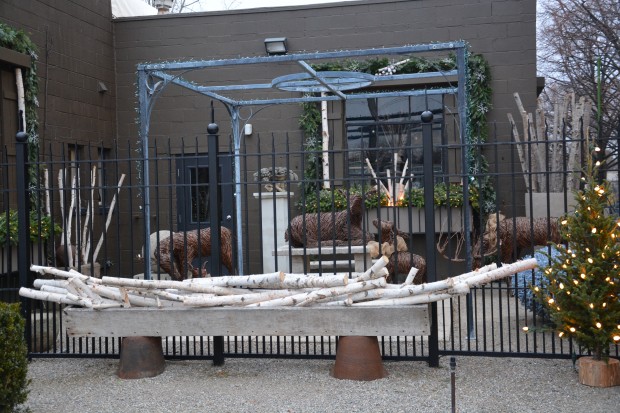 A good supplier called-he had purchased a big load of beautiful birch poles, ranging in size from 1″ to 4″ in diameter. Were we interested? The prospect of a great material becoming available sparks all kinds of ideas. Of course we were interested. I had some time to design-there was a lot of work to be done before we would be ready to get our home done for the holidays. Birch poles are extraordinarily beautiful, and notoriously difficult to work with. They are big, clunky, and heavy. They don’t give an inch. Anything you do with them involves plenty of engineering. My favorite part of this holiday scheme-the poles arranged in a long vintage English wood trough. The overall curve has everything to do with the pattern of the stacking stacking-the poles themselves are straight as straight can be. Birch poles in containers can be overwhelming. I have seen plenty of birch poles that look like birch stumps. No grace. The challenge of the poles was going to be great fun.
A good supplier called-he had purchased a big load of beautiful birch poles, ranging in size from 1″ to 4″ in diameter. Were we interested? The prospect of a great material becoming available sparks all kinds of ideas. Of course we were interested. I had some time to design-there was a lot of work to be done before we would be ready to get our home done for the holidays. Birch poles are extraordinarily beautiful, and notoriously difficult to work with. They are big, clunky, and heavy. They don’t give an inch. Anything you do with them involves plenty of engineering. My favorite part of this holiday scheme-the poles arranged in a long vintage English wood trough. The overall curve has everything to do with the pattern of the stacking stacking-the poles themselves are straight as straight can be. Birch poles in containers can be overwhelming. I have seen plenty of birch poles that look like birch stumps. No grace. The challenge of the poles was going to be great fun.
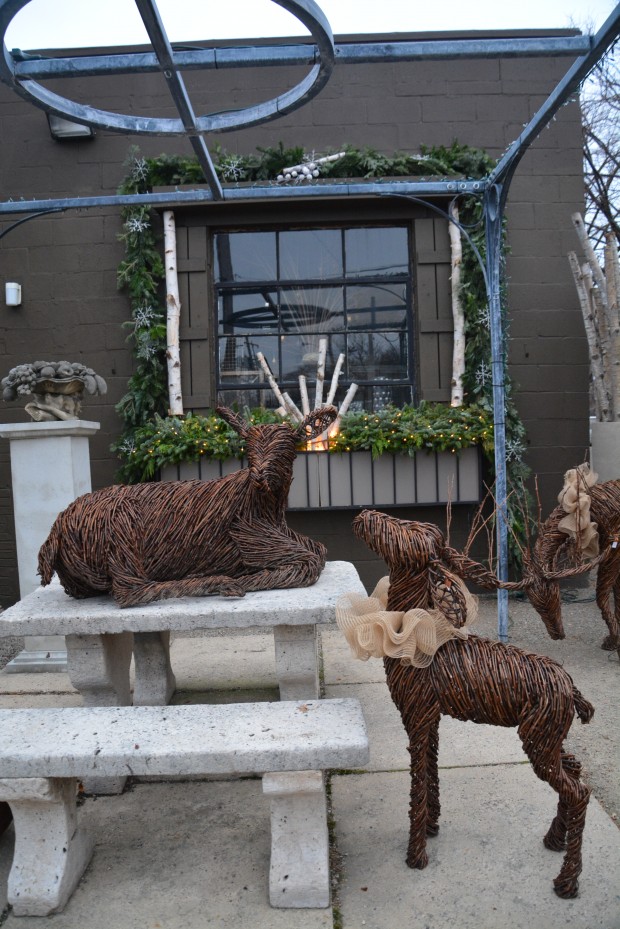 If you live in Michigan, you know about the beautiful stands of white birch in our upper peninsula. Birch in my area of lower Michigan-really troublesome to grow. Birch borer is a deadly pest. Japanese beetles can chew every leaf off a tree in no time. White paper birch is always a gamble in the landscape. The Himalayan white barked birch, Betulus Jacquemontii, is equally as susceptible. I do plant it, as the trunks are bright white an an early age. Every planting of them comes with a maintenance plan attached. The size and age stands of old birch in the northern parts of Michigan are testament to the power of nature. Extremely cold winter weather kills the borers. The trees grow to maturity. An old and mature birch tree is incredibly beautiful.
If you live in Michigan, you know about the beautiful stands of white birch in our upper peninsula. Birch in my area of lower Michigan-really troublesome to grow. Birch borer is a deadly pest. Japanese beetles can chew every leaf off a tree in no time. White paper birch is always a gamble in the landscape. The Himalayan white barked birch, Betulus Jacquemontii, is equally as susceptible. I do plant it, as the trunks are bright white an an early age. Every planting of them comes with a maintenance plan attached. The size and age stands of old birch in the northern parts of Michigan are testament to the power of nature. Extremely cold winter weather kills the borers. The trees grow to maturity. An old and mature birch tree is incredibly beautiful.
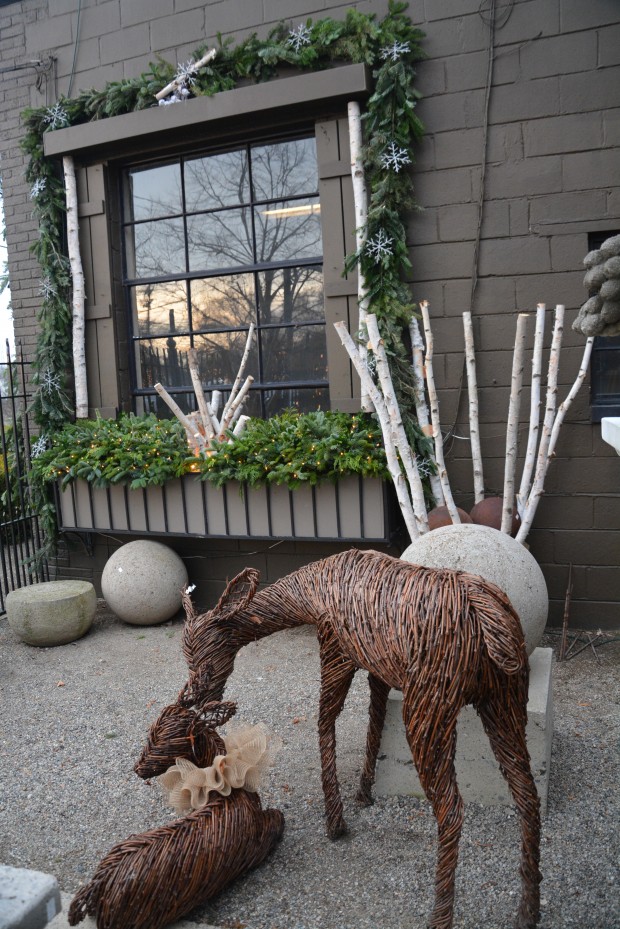 This green and white winter scheme is punctuated by members of our grapevine deer collection. Their curving and quite sculptural forms stand in stark contrast to those implacably white and implacably straight poles.
This green and white winter scheme is punctuated by members of our grapevine deer collection. Their curving and quite sculptural forms stand in stark contrast to those implacably white and implacably straight poles.
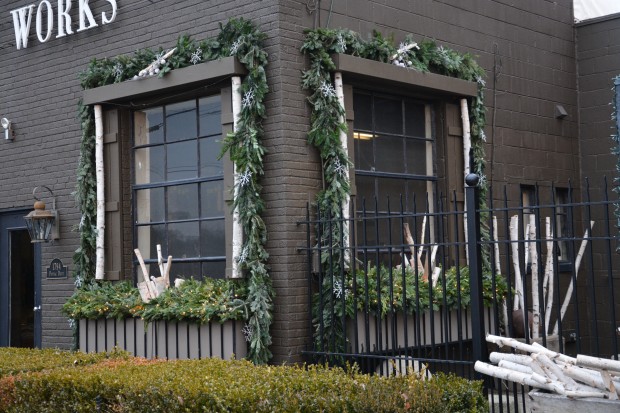 The shop windows got the full treatment. A pair of 6 foot long birch poles frame the shutters. Thick fir garlands were draped over the window hats- to which we wired whitewashed snowflakes. A short, narrow, and angularly placed birch branch in the center of the garland overhead was kept company by a few snowball picks. The boxes are stuffed to overflowing with mixed greens. Fir, incense cedar, berried juniper, white pine, shore pine, noble fir, silver fir, mountain hemlock and German boxwood all mixed together-friendly, and warm. Like a thick blanket. The very cold is soon to come for us. We mean to be ready.
The shop windows got the full treatment. A pair of 6 foot long birch poles frame the shutters. Thick fir garlands were draped over the window hats- to which we wired whitewashed snowflakes. A short, narrow, and angularly placed birch branch in the center of the garland overhead was kept company by a few snowball picks. The boxes are stuffed to overflowing with mixed greens. Fir, incense cedar, berried juniper, white pine, shore pine, noble fir, silver fir, mountain hemlock and German boxwood all mixed together-friendly, and warm. Like a thick blanket. The very cold is soon to come for us. We mean to be ready.
 The Dutch wicker pots out front took to this birchy and natural look without a hitch. Dark varnished twigs and snowball picks made a striking centerpiece.
The Dutch wicker pots out front took to this birchy and natural look without a hitch. Dark varnished twigs and snowball picks made a striking centerpiece.
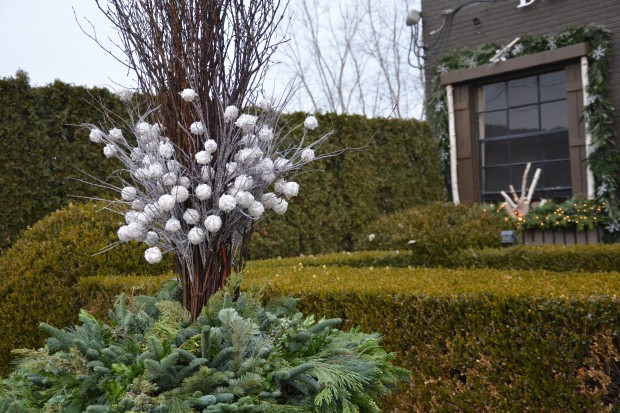 Winter and holiday picks have their place. The gracefully curving white washed snow ball picks are a contrast to the clipped hedges, and those poles. I would use any material available to me for a winter container arrangement-both natural and not. The idea here is to celebrate and take pleasure from a season in which the garden is dormant. Anything goes. Anything could be great. Anything might bring a holiday smile to your face. I love this holiday season, and plan to celebrate the garden gone quiet in any way available to me.
Winter and holiday picks have their place. The gracefully curving white washed snow ball picks are a contrast to the clipped hedges, and those poles. I would use any material available to me for a winter container arrangement-both natural and not. The idea here is to celebrate and take pleasure from a season in which the garden is dormant. Anything goes. Anything could be great. Anything might bring a holiday smile to your face. I love this holiday season, and plan to celebrate the garden gone quiet in any way available to me.
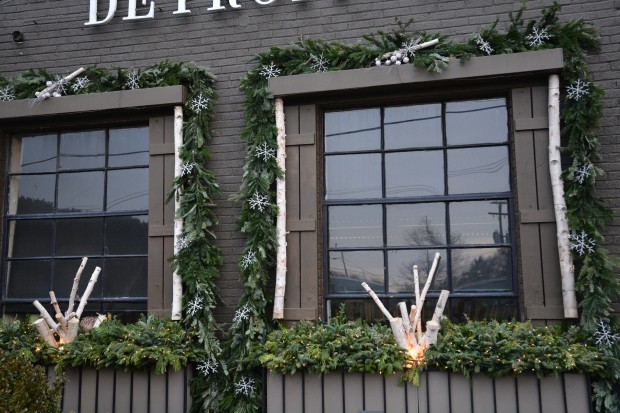 The shorter birch centerpieces were placed over a nest of C-9 white lights. We hope to evoke the memory of a fireplace ablaze on a cold winter’s night.
The shorter birch centerpieces were placed over a nest of C-9 white lights. We hope to evoke the memory of a fireplace ablaze on a cold winter’s night.
 The poles on the roof were all engineering and secured by the fabricating staff at Branch. It can get very windy up there, so I wanted to be sure everything was completely secure.
The poles on the roof were all engineering and secured by the fabricating staff at Branch. It can get very windy up there, so I wanted to be sure everything was completely secure.
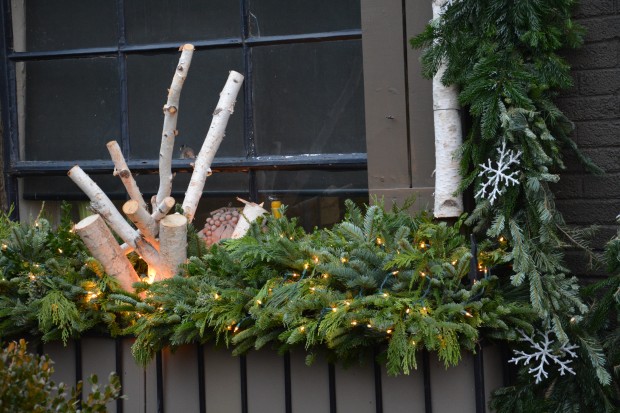 A lighted window box-the C-9’s illuminate the birch stacks. 100 count strands of mini lights illuminate the greens.
A lighted window box-the C-9’s illuminate the birch stacks. 100 count strands of mini lights illuminate the greens.
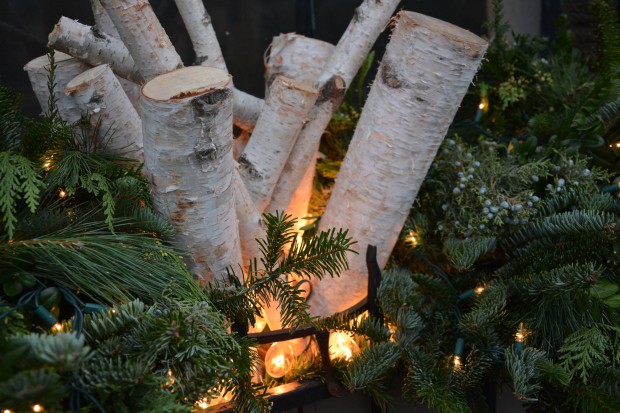 The dark of the evergreen boughs and the white of the birch are in stark contrast to one another-too stark, in my opinion. But we are waiting for the last element to complete our display-the snow. Once we have snow, I think we will have our own version of a Michigan winter wonderland. This is a good thing-to be ready for the snow.
The dark of the evergreen boughs and the white of the birch are in stark contrast to one another-too stark, in my opinion. But we are waiting for the last element to complete our display-the snow. Once we have snow, I think we will have our own version of a Michigan winter wonderland. This is a good thing-to be ready for the snow.
